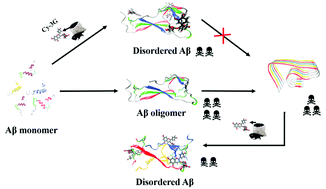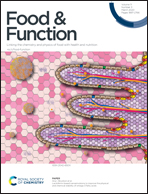Cyanidin-3-O-glucoside inhibits Aβ40 fibrillogenesis, disintegrates preformed fibrils, and reduces amyloid cytotoxicity†
Abstract
Alzheimer's disease (AD) is mainly caused by the fibrillogenesis of amyloid-β protein (Aβ). Therefore, the development of effective inhibitors against Aβ fibrillogenesis offers great hope for the treatment of AD. Cyanidin-3-O-glucoside (Cy-3G) is a commonly found anthocyanin that is mainly present in fruits, with established neuroprotective effects in situ. However, it remains unknown if Cy-3G can prevent Aβ fibrillogenesis and alleviate the corresponding cytotoxicity. In this study, extensive biochemical, biophysical, biological and computational experiments were combined to address this issue. It was found that Cy-3G significantly inhibits Aβ40 fibrillogenesis and disintegrates mature Aβ fibrils, and its inhibitory capacity is dependent on the Cy-3G concentration. The circular dichroism results showed that Cy-3G and Aβ40 at a molar ratio of 3 : 1 slightly prevents the structural transformation of Aβ40 from its initial random coil to the β-sheet-rich structure. Co-incubation of Aβ40 with Cy-3G significantly reduced the production of intracellular reactive oxygen species induced by Aβ40 fibrillogenesis and thus reduced Aβ40-induced cytotoxicity. Molecular dynamics simulations revealed that Cy-3G disrupted the β-sheet structure of the Aβ40 trimer. Cy-3G was found to mainly interact with the N-terminal region, the central hydrophobic cluster and the β-sheet region II via hydrophobic and electrostatic interactions. The ten hot spot residues D7, Y10, E11, F19, F20, E22, I31, I32, M35 and V40 were also identified. These findings not only enable a comprehensive understanding of the inhibitory effect of Cy-3G on Aβ40 fibrillogenesis, but also allow the identification of a valuable dietary ingredient that possesses great potential to be developed into functional foods to alleviate AD.



 Please wait while we load your content...
Please wait while we load your content...